Geomagnetic storm
In the night of 6 to 7 April 2000, the northern light or aurora was seen throughout all Belgium. The Solar Influences Data Center (Royal Observatory of Belgium) was flooded by telephones and emails from people in Gent, Limburg, Brussels and Liège who saw moving bands in colours varying from red-orange to purple. Good viewing of the event was enhanced by open and clear skies as well as a slender crescent moon.
The northern light or aurora is a common phenomenon at high latitudes such as Norway or Finland but rather exceptional in Belgium. Presently, the Sun is at its peak level in its 11 year activity cycle which enhances the chances for such events. More info on aurora at the University of Alaska.
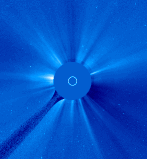
This disturbance is most likely the consequence of a so-called halo coronal mass ejection which was observed by the Solar and Heliospheric Observatory (space mission of ESA/NASA), following a c9/2f flare at 15h41 UT, April 4. The arrival of a disturbance at the earth orbit was detected by the ACE satellite on April 6, 16h00 UT by a sudden jump of the solar wind speed from a regular 370 km/s to almost 600 km/s.
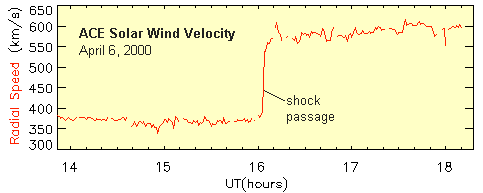
The impact of such disturbances can create so-called geomagnetic storms, which in turn lead to the observed aurora. The Kp index is a 3-hourly measure of the geomagnetic activity and scales from 0 to 9. In the night of 6 to 7 April, this index was clearly larger than usual.
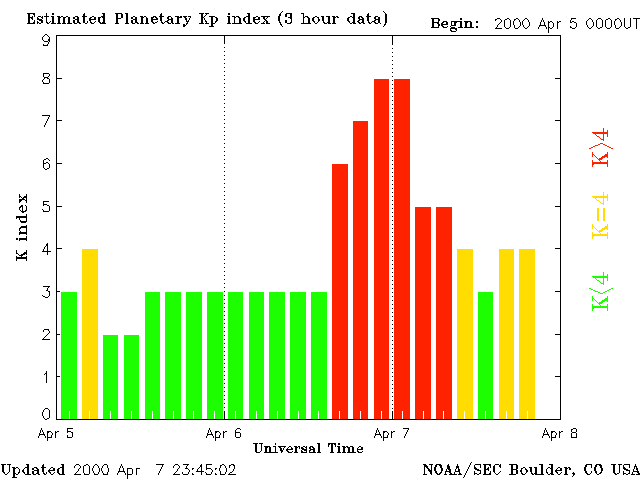
Observations from Belgium
Photographs kindly provided by Jean Bourgeois, 7/4/2000 20h45 UT, Pentax camera, Kodak gold ISO 1000 film.
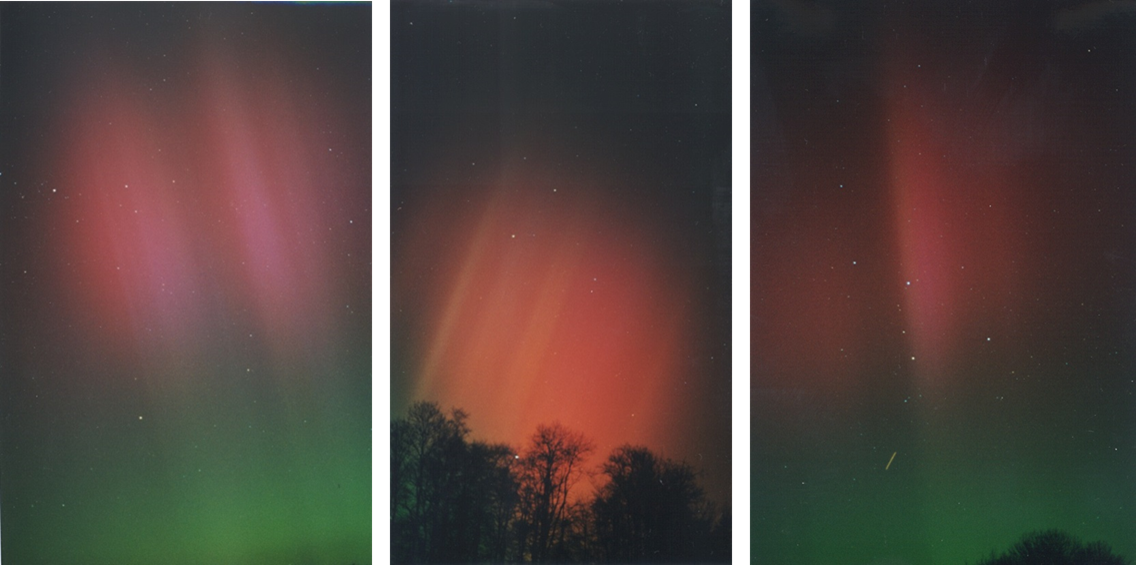
Article in the Flemish newspaper 'De Standaard' on 8-9th April 2000.
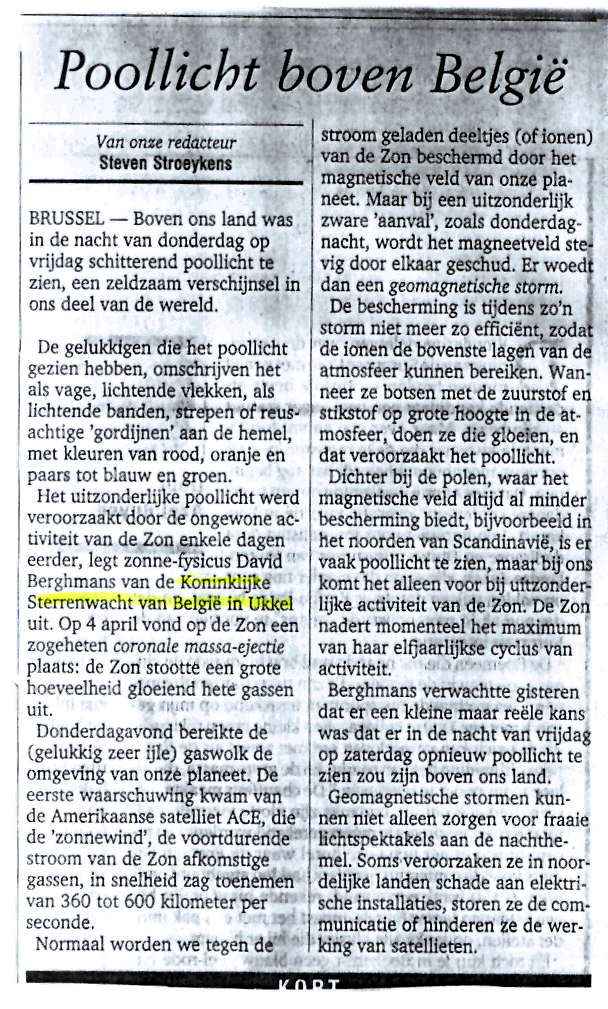
The aurora borealis display has widely been seen in Belgium, and many amateur astronomers made eye-witness reports or photographs of the event.
An eye-witness report and photographs have kindly been provided by Tom Corstjens who observed the aurora display in Bocholt. Times are in Universal Time. He used a Minolta X-700 camera with a Kodak Gold 200 ASA film and a 50 mm standard lens. He used exposure times between 3 to 9 seconds.

First maximum in activity
20h04 : First detection of red light-spot in the head of Draco.
20h08 : Expansion of spot to the west (Cassiopeia), with a bright vertical zone west of Cepheus.
20h09 : Appearance of red stripe through Cassiopeia, direction Polaris. 20h10 : Very broad, fuzzy red band from Cassiopeia to Cepheus and the head of Draco.
20h12 : Fuzzy band becomes three bright zones: vertical stripes in Cassiopeia, fuzzy zone in Cepheus and very bright red spot in the head of Draco.
20h15 : Bright stripes in Cassiopeia move to zenith.
20h20 : Fading zones in Cassiopeia and Cepheus.
20h23 : Zone in Draco brightens strongly en grows eastwards to horizon.
20h28 : Fading of every detail (not much to be seen).
20h44 : Renewed appearance of red zones around the head of Draco and Cepheus, with a bright vertical line to Polaris.
20h46 : Draco spot brightens and moves to the horizon, direction Wega.
20h48 : Aurora disappears.
20h50 : Sudden appearance of very bright zones in Perseus. For a short while the appearance of weak white stripe patterns on top of red spot, spread over the whole north pole region.
20h51 : Very bright red line from Cepheus to east of Wega.
20h53 : Appearance of red spot east of Wega.
20h55 : Very bright white stripe in Cepheus.
20h56 : Strong awakening of red light in the northern sky, whereby only bright stars of magnitude 2 and less, are visible. Especially the zone in Perseus and Draco is very bright red.
21h01 : Maximum of Aurora display, where in Perseus about ten bright white lines against a red background, are visible. These lines move in a wave-like manner to the right and seem to converge in the zenith. These lines seem sometimes to unravel, and to recombine at other locations. Between the white lines, green details are visible, which move with the white lines. Size of activity region: 20 degrees above the horizon with a width of more than 120 degrees. This is the most impressive phenomena of the whole night, and resembles the typical images of aurora borealis. There is also a strong intense red zone in Draco, forming the eastern boundary of the aurora. This has a size of 25 by 25 degrees, and is low at the horizon. There are no details visible here, but the strong red colour is conspicuous. Between the two regions, there is red light, but less bright. It shows vertical red bands, that also seems to move to the right in a wave-like manner. This zone reaches Polaris. Very noticeable is that the Aurora does not start at the horizon, but that there is a bright white halo visible there, with a maximum height of 20 degrees above the horizon. Only above the halo does the aurora begin. All these event just described last approximately 5 minutes, after which the moving white lines in Perseus disappear.
21h06 : Bright red line in Cassiopeia.
21h08 : Aurora fades and is faintly visible in Cassiopeia and south of Bootes.
21h13 : Appearance of white-red spot in Perseus.
21h14 : Zone in Perseus brightens and fades.
21h18 : Bright red vertical band in Perseus.
21h19 : Fading of the red spot, moving to Auriga.
21h22 : Bright red line at the height of zeta Persei towards the zenith, and a brightening of the west-side of the red spot.
21h24 : Red zone grows towards Aldebaran.
21h26 : Appearance of drape of red lines, west of Perseus.
21h31 : Bright slant red lines throught Gemini.
21h36 : no aurora.
21h37 : Two bright-red lines above horizon in Gemini.
21h40 : Everything fades and only a light-red haze is visible around Perseus. Bright white halo at horizon is already visible for one hour, seems to shift westwards.
21h52 : Brightening of red zone in Auriga.
21h55 : White halo fades and red zone grows towards the horizon.
21h59 : At the eastside of red zone a white haze appears.
22h02 : All details disappear, only a red haze in Auriga.
22h08 : Disappearance of aurora.
Second maximum in activity
23h11 : Appearance of a red spot at western horizon.
23h13 : Light strip-pattern present east of Auriga.
23h15 : Second red spot appears around gamma Cephei and head of Draco.
23h17 : Previous three spots merge and from a big red region with three brighter parts.
23h18 : Appearance of white line-pattern in red zone (Auriga).
23h19 : Second maximum. Appearance of one very bright broad white line above Auriga. This line splits in to three finer lines, which reach the zenith. It appears as if a great red rain cloud is filling half the sky. There is much white light present, from the horizon up to 50 degrees. There are practically no stars visible.
23h30 : Very bright red spot appears in Lyra, with line-pattern.
23h34 : Very bright white cloud above Bootes for 2 minutes.
23h37 : Activity in Cassiopeia: line-pattern with in the east a bright, clear red line.
23h40 : Fading of aurora. Only fine line-patterns remain visible. Red features disappear, white features remain.
23h50 : Appearance of red lines through Cepheus and Cygnus.
23h54 : Appearance of clear white band at eastern horizon, from which one bright red slant line is pointing high in the sky.
23h57 : Only weak white 'veal' present, all red details disappeared.
23h59 : White stripe in Cepheus.
0h05 : Red spot in Gemini.
0h08 : Very bright white band under Leo, with small draping towards zenith.
0h09 : White band disappears, only the small white draping remains.
0h11 : White band reappears for a little while.
0h14 : Thin red raping from Gemini to Ursa Minor.
0h17 : Big red spot above Auriga and appearance of white draping.
0h19 : No aurora.
0h24 : Above Auriga a weak red glow appears, with four clear bright red lines. These lines remain long.
0h30 : The easterly line of the four varies in intensity, and grows towards Ursa Major. There two bright lines are visible.
0h36 : Red spot in Cygnus, that grows westerly.
0h44 : End of aurora borealis display.





